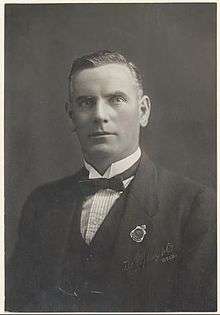George John Bell
| Sir George Bell KCMG, DSO, VD | |
|---|---|
 | |
| 9th Speaker of the Australian House of Representatives | |
|
In office 23 October 1934 – 19 November 1940 | |
| Preceded by | George Mackay |
| Succeeded by | Walter Nairn |
| Member of the Australian Parliament for Darwin | |
|
In office 13 December 1919 – 16 December 1922 | |
| Preceded by | William Spence |
| Succeeded by | Joshua Whitsitt |
|
In office 14 November 1925 – 7 July 1943 | |
| Preceded by | Joshua Whitsitt |
| Succeeded by | Enid Lyons |
| Personal details | |
| Born |
29 November 1872 Sale, Victoria |
| Died |
5 May 1944 (aged 71) Burnie, Tasmania |
| Nationality | Australian |
| Political party |
Nationalist (1919–31) UAP (1931–43) |
| Occupation | Soldier |
| Military service | |
| Allegiance | Australia |
| Years of service | 1892–1927 |
| Rank | Lieutenant Colonel |
| Commands |
26th Light Horse Regiment (1920–27) 3rd Light Horse Regiment (1917–19) |
| Battles/wars | |
| Awards |
Knight Commander of the Order of St Michael and St George Distinguished Service Order Mentioned in Despatches (2) Volunteer Officers' Decoration |
Sir George John Bell KCMG, DSO, VD (29 November 1872 – 5 March 1944) was an Australian soldier and politician. Bell was born in Sale in the state of Victoria, and was the eldest son of George Bell and Catherine Bell, née Hussey. Bell was one of 15 siblings, including William R. Bell. He received his education in the outback of Victoria, and worked on his parent's farm, before joining the Victorian Mounted Rifles.[1]
Following the outbreak of the Second Boer War, Bell enlisted in Victorian Mounted Infantry as a private. Although travelling back to Australia after the disbandment of the Infantry, he returned to the war, joining the Victorian Mounted Rifles Contingent. He was commissioned as a lieutenant, but became severely injured in a battle in early 1902. He was awarded a Distinguished Service Order for his services in the war.[1]
After the war, Bell returned to Australia, settling in the state of Tasmania. On the outbreak of the First World War, Bell enlisted for the Australian Imperial Forces, and was dispatched for training in Egypt. He served at Gallipoli and Sinai, and was promoted from the rank of lieutenant to captain, to major and finally, to lieutenant colonel. Given command of the 3rd Light Horse Regiment, Bell's most successful conquest was the capture of Es Salt, and the later successful evacuation of British troops from the stronghold. He was appointed a Companion of the Order of St Michael and St George in April, 1919.[1]
After his return to Australia, Bell married Ellen Rothwell on 5 November 1919. He became the Nationalist Party candidate for the Division of Darwin (Tasmania), and was elected to the Australian House of Representatives in the federal election of 1919. He remained in the post for 21 years (1919 – 1922 and 1925 – 1943), representing the Nationalist Party and its successor party, the United Australia Party. Bell was appointed the aide-de-camp to the Governor-General of Australia. Elected as chairman of committees to the House of Representatives, he became Speaker of the Australian House of Representatives in 1934. Appointed as Knight Commander of the Order of St Michael and St George in 1941, Bell retired from politics in 1943. Bell died from cardiovascular disease in Tasmania, and was buried in the Burnie Anglican cemetery, following a state funeral.[1]
External links
- My Tasmanian Families at the Wayback Machine (archived 26 October 2009)
Footnotes
- 1 2 3 4 Bell, William G. (1979). "Bell, Sir George John (1872–1944)". Australian Dictionary of Biography (Volume 7 ed.). Melbourne University Press.
| Parliament of Australia | ||
|---|---|---|
| Preceded by George Mackay |
Speaker of the Australian House of Representatives 1934–1940 |
Succeeded by Walter Nairn |
| Preceded by William Spence |
Member for Darwin 1919–1922 |
Succeeded by Joshua Whitsitt |
| Preceded by Joshua Whitsitt |
Member for Darwin 1925–1943 |
Succeeded by Enid Lyons |